Application of Image Recognition Methods to Determine Land Use Classes
Abstract
Featured Application
Abstract
1. Introduction
- An enhanced data pre-processing workflow is presented, demonstrating a substantial improvement in classification performance through effective management of cloud-covered satellite images.
- An advanced feature selection strategy using vegetation indices to improve class separability was employed.
- A post-processing approach that utilizes confidence maps to refine classification results and reduce misclassification errors was proposed.
- The results of experiments performed on the territory of Lithuania demonstrated a substantial enhancement in classification accuracy, taking into account the diverse land use classes, seasonal variations, and frequent cloud cover present in the region.
2. Related Works
3. Materials and Methods
3.1. Satellite Data Acquisition
3.2. Satellite Data Pre-Processing
3.3. Satellite Data Classification
3.4. Satellite Data Post-Processing
4. Results
4.1. Satellite Data Acquisition Results
4.2. Pre-Processing Results
4.3. Classification Results and Reached Accuracy
4.3.1. Most Accurate Classifier
4.3.2. Final Classification Results
4.4. Post-Processing Results
5. Discussion
Limitations of the Research
6. Conclusions and Future Works
Author Contributions
Funding
Institutional Review Board Statement
Informed Consent Statement
Data Availability Statement
Conflicts of Interest
References
- Flohr, P.; Bradbury, J.; ten Harkel, L. Tracing the Patterns: Fields, Villages, and Burial Places in Lebanon. Levant 2021, 53, 315–335. [Google Scholar] [CrossRef]
- Marchetti, G.; Bizzi, S.; Belletti, B.; Lastoria, B.; Comiti, F.; Carbonneau, P.E. Mapping Riverbed Sediment Size from Sentinel-2 Satellite Data. Earth Surf. Process. Landf. 2022, 47, 2544–2559. [Google Scholar] [CrossRef]
- Zhang, T.X.; Su, J.Y.; Liu, C.J.; Chen, W.H. Potential Bands of Sentinel-2A Satellite for Classification Problems in Precision Agriculture. Int. J. Autom. Comput. 2019, 16, 16–26. [Google Scholar] [CrossRef]
- Dobrinić, D.; Gašparović, M.; Medak, D. Sentinel-1 and 2 Time-Series for Vegetation Mapping Using Random Forest Classification: A Case Study of Northern Croatia. Remote Sens. 2021, 13, 2321. [Google Scholar] [CrossRef]
- Xue, H.; Xu, X.; Zhu, Q.; Yang, G.; Long, H.; Li, H.; Yang, X.; Zhang, J.; Yang, Y.; Xu, S.; et al. Object-Oriented Crop Classification Using Time Series Sentinel Images from Google Earth Engine. Remote Sens. 2023, 15, 1353. [Google Scholar] [CrossRef]
- Fan, Z.; Zhan, T.; Gao, Z.; Li, R.; Liu, Y.; Zhang, L.; Jin, Z.; Xu, S. Land Cover Classification of Resources Survey Remote Sensing Images Based on Segmentation Model. IEEE Access 2022, 10, 56267–56281. [Google Scholar] [CrossRef]
- Eisfelder, C.; Boemke, B.; Gessner, U.; Sogno, P.; Alemu, G.; Hailu, R.; Mesmer, C.; Huth, J. Cropland and Crop Type Classification with Sentinel-1 and Sentinel-2 Time Series Using Google Earth Engine for Agricultural Monitoring in Ethiopia. Remote Sens. 2024, 16, 866. [Google Scholar] [CrossRef]
- Farhadiani, R.; Homayouni, S.; Bhattacharya, A.; Mahdianpari, M. Crop Classification Using Multi-Temporal RADARSAT Constellation Mission Compact Polarimetry SAR Data. Can. J. Remote Sens. 2024, 50, 2384883. [Google Scholar] [CrossRef]
- Wang, Y.; Jin, S.; Dardanelli, G. Vegetation Classification and Evaluation of Yancheng Coastal Wetlands Based on Random Forest Algorithm from Sentinel-2 Images. Remote Sens. 2024, 16, 1124. [Google Scholar] [CrossRef]
- Roy, D.P.; Li, J.; Zhang, H.K.; Yan, L. Best Practices for the Reprojection and Resampling of Sentinel-2 Multi Spectral Instrument Level 1C Data. Remote Sens. Lett. 2016, 7, 1023–1032. [Google Scholar] [CrossRef]
- Arp, L.; Hoos, H.; van Bodegom, P.; Francis, A.; Wheeler, J.; van Laar, D.; Baratchi, M. Training-Free Thick Cloud Removal for Sentinel-2 Imagery Using Value Propagation Interpolation. ISPRS J. Photogramm. Remote Sens. 2024, 216, 168–184. [Google Scholar] [CrossRef]
- Meraner, A.; Ebel, P.; Zhu, X.X.; Schmitt, M. Cloud Removal in Sentinel-2 Imagery Using a Deep Residual Neural Network and SAR-Optical Data Fusion. ISPRS J. Photogramm. Remote Sens. 2020, 166, 333–346. [Google Scholar] [CrossRef]
- Bill Donatien, L.M.; Biona Clobite, B.; Lemvo Meris Midel, M. Comparing Sentinel-2 and Landsat 9 for Land Use and Land Cover Mapping Assessment in the North of Congo Republic: A Case Study in Sangha Region. Int. J. Remote Sens. 2024, 45, 8015–8036. [Google Scholar] [CrossRef]
- Trevisiol, F.; Mandanici, E.; Pagliarani, A.; Bitelli, G. Evaluation of Landsat-9 Interoperability with Sentinel-2 and Landsat-8 over Europe and Local Comparison with Field Surveys. ISPRS J. Photogramm. Remote Sens. 2024, 210, 55–68. [Google Scholar] [CrossRef]
- Poussin, C.; Peduzzi, P.; Giuliani, G. Snow Observation from Space: An Approach to Improving Snow Cover Detection Using Four Decades of Landsat and Sentinel-2 Imageries across Switzerland. Sci. Remote Sens. 2025, 11, 100182. [Google Scholar] [CrossRef]
- Cuypers, S.; Nascetti, A.; Vergauwen, M. Land Use and Land Cover Mapping with VHR and Multi-Temporal Sentinel-2 Imagery. Remote Sens. 2023, 15, 2501. [Google Scholar] [CrossRef]
- Bio Nikki Sarè, S.B.; Gaetano, R.; Interdonato, R.; Hountondji, Y.C.; Ienco, D.; Dantas, C.F. Joint Cloud Removal and Classification of Sentinel-2 Image Time Series for Agricultural Land Cover Mapping in Northern Benin. In Proceedings of the IGARSS 2024—2024 IEEE International Geoscience and Remote Sensing Symposium, Athens, Greece, 7–12 July 2024; pp. 4824–4827. [Google Scholar]
- Huang, H.; Roy, D.P.; De Lemos, H.; Qiu, Y.; Zhang, H.K. A Global Swin-Unet Sentinel-2 Surface Reflectance-Based Cloud and Cloud Shadow Detection Algorithm for the NASA Harmonized Landsat Sentinel-2 (HLS) Dataset. Sci. Remote Sens. 2025, 11, 100213. [Google Scholar] [CrossRef]
- Patel, P.N.; Jiang, J.H.; Gautam, R.; Gadhavi, H.; Kalashnikova, O.; Garay, M.J.; Gao, L.; Xu, F.; Omar, A. A Remote Sensing Algorithm for Vertically Resolved Cloud Condensation Nuclei Number Concentrations from Airborne and Spaceborne Lidar Observations. Atmos. Chem. Phys. 2024, 24, 2861–2883. [Google Scholar] [CrossRef]
- Zhou, J.; Luo, X.; Rong, W.; Xu, H. Cloud Removal for Optical Remote Sensing Imagery Using Distortion Coding Network Combined with Compound Loss Functions. Remote Sens. 2022, 14, 3452. [Google Scholar] [CrossRef]
- Wang, Q.; Wang, L.; Zhu, X.; Ge, Y.; Tong, X.; Atkinson, P.M. Remote Sensing Image Gap Filling Based on Spatial-Spectral Random Forests. Sci. Remote Sens. 2022, 5, 100048. [Google Scholar] [CrossRef]
- Kumar, A.; Abhishek, K.; Kumar Singh, A.; Nerurkar, P.; Chandane, M.; Bhirud, S.; Patel, D.; Busnel, Y. Multilabel Classification of Remote Sensed Satellite Imagery. Trans. Emerg. Telecommun. Technol. 2021, 32, e3988. [Google Scholar] [CrossRef]
- Albertini, C.; Gioia, A.; Iacobellis, V.; Petropoulos, G.P.; Manfreda, S. Assessing Multi-Source Random Forest Classification and Robustness of Predictor Variables in Flooded Areas Mapping. Remote Sens. Appl. 2024, 35, 101239. [Google Scholar] [CrossRef]
- Judah, A.; Hu, B. The Integration of Multi-Source Remotely Sensed Data with Hierarchically Based Classification Approaches in Support of the Classification of Wetlands. Can. J. Remote Sens. 2022, 48, 158–181. [Google Scholar] [CrossRef]
- Ioannou, K. On the Identification of Agroforestry Application Areas Using Object-Oriented Programming. Agriculture 2023, 13, 164. [Google Scholar] [CrossRef]
- Alhassan, V.; Henry, C.; Ramanna, S.; Storie, C. A Deep Learning Framework for Land-Use/Land-Cover Mapping and Analysis Using Multispectral Satellite Imagery. Neural Comput. Appl. 2020, 32, 8529–8544. [Google Scholar] [CrossRef]
- Hejmanowska, B.; Kramarczyk, P. Assessing Land Cover Changes Using the LUCAS Database and Sentinel Imagery: A Comparative Analysis of Accuracy Metrics. Appl. Sci. 2025, 15, 240. [Google Scholar] [CrossRef]
- Li, C.; Li, H.; Zhou, Y.; Wang, X. Detailed Land Use Classification in a Rare Earth Mining Area Using Hyperspectral Remote Sensing Data for Sustainable Agricultural Development. Sustainability 2024, 16, 3582. [Google Scholar] [CrossRef]
- Perregrini, D.; Casella, V. Land Use Recognition by Applying Fuzzy Logic and Object-Based Classification to Very High Resolution Satellite Images. Remote Sens. 2024, 16, 2273. [Google Scholar] [CrossRef]
- Shao, M.; Xie, X.; Li, K.; Li, C.; Zhou, X. Semantic-Enhanced Foundation Model for Coastal Land Use Recognition from Optical Satellite Images. Appl. Sci. 2024, 14, 9431. [Google Scholar] [CrossRef]
- Holloway, J.; Helmstedt, K.J.; Mengersen, K.; Schmidt, M. A Decision Tree Approach for Spatially Interpolating Missing Land Cover Data and Classifying Satellite Images. Remote Sens. 2019, 11, 1796. [Google Scholar] [CrossRef]
- Souza, F.E.S.d.; Rodrigues, J.I.d.J. Evaluation of Machine Learning Algorithms in the Classification of Multispectral Images from the Sentinel-2A/2B Orbital Sensor for Mapping the Environmental Dynamics of Ria Formosa (Algarve, Portugal). ISPRS Int. J. Geo-Inf. 2023, 12, 361. [Google Scholar] [CrossRef]
- Kamenova, I.; Chanev, M.; Dimitrov, P.; Filchev, L.; Bonchev, B.; Zhu, L.; Dong, Q. Crop Type Mapping and Winter Wheat Yield Prediction Utilizing Sentinel-2: A Case Study from Upper Thracian Lowland, Bulgaria. Remote Sens. 2024, 16, 1144. [Google Scholar] [CrossRef]
- Kluczek, M.; Zagajewski, B.; Kycko, M. Combining Multitemporal Optical and Radar Satellite Data for Mapping the Tatra Mountains Non-Forest Plant Communities. Remote Sens. 2024, 16, 1451. [Google Scholar] [CrossRef]
- Kluczek, M.; Zagajewski, B.; Zwijacz-Kozica, T. Mountain Tree Species Mapping Using Sentinel-2, PlanetScope, and Airborne HySpex Hyperspectral Imagery. Remote Sens. 2023, 15, 844. [Google Scholar] [CrossRef]
- Aliabad, F.A.; Malamiri, H.R.G.; Shojaei, S.; Sarsangi, A.; Ferreira, C.S.S.; Kalantari, Z. Investigating the Ability to Identify New Constructions in Urban Areas Using Images from Unmanned Aerial Vehicles, Google Earth, and Sentinel-2. Remote Sens. 2022, 14, 3227. [Google Scholar] [CrossRef]
- Bebie, M.; Cavalaris, C.; Kyparissis, A. Assessing Durum Wheat Yield through Sentinel-2 Imagery: A Machine Learning Approach. Remote Sens. 2022, 14, 3880. [Google Scholar] [CrossRef]
- Zhang, H.; He, J.; Chen, S.; Zhan, Y.; Bai, Y.; Qin, Y. Comparing Three Methods of Selecting Training Samples in Supervised Classification of Multispectral Remote Sensing Images. Sensors 2023, 23, 8530. [Google Scholar] [CrossRef]
- Pokhariya, H.S.; Singh, D.P.; Prakash, R. Evaluation of Different Machine Learning Algorithms for LULC Classification in Heterogeneous Landscape by Using Remote Sensing and GIS Techniques. Eng. Res. Express 2023, 5, 045052. [Google Scholar] [CrossRef]
- Kycko, M.; Zagajewski, B.; Kluczek, M.; Tardà, A.; Pineda, L.; Palà, V.; Corbera, J. Sentinel-2 and AISA Airborne Hyperspectral Images for Mediterranean Shrubland Mapping in Catalonia. Remote Sens. 2022, 14, 5531. [Google Scholar] [CrossRef]
- Ren, C.; Jiang, H.; Xi, Y.; Liu, P.; Li, H. Quantifying Temperate Forest Diversity by Integrating GEDI LiDAR and Multi-Temporal Sentinel-2 Imagery. Remote Sens. 2023, 15, 375. [Google Scholar] [CrossRef]
- Arfa, A.; Minaei, M. Utilizing Multitemporal Indices and Spectral Bands of Sentinel-2 to Enhance Land Use and Land Cover Classification with Random Forest and Support Vector Machine. Adv. Space Res. 2024, 74, 5580–5590. [Google Scholar] [CrossRef]
- Keskes, M.I.; Mohamed, A.H.; Borz, S.A.; Niţă, M.D. Improving National Forest Mapping in Romania Using Machine Learning and Sentinel-2 Multispectral Imagery. Remote Sens. 2025, 17, 715. [Google Scholar] [CrossRef]
- Caputi, E.; Delogu, G.; Patriarca, A.; Perretta, M.; Mancini, G.; Boccia, L.; Recanatesi, F.; Ripa, M.N. Comparison of Tree Typologies Mapping Using Random Forest Classifier Algorithm of PRISMA and Sentinel-2 Products in Different Areas of Central Italy. Remote Sens. 2025, 17, 356. [Google Scholar] [CrossRef]
- Wang, Z. Spatial Differentiation Characteristics of Rural Areas Based on Machine Learning and GIS Statistical Analysis—A Case Study of Yongtai County, Fuzhou City. Sustainability 2023, 15, 4367. [Google Scholar] [CrossRef]
- Stachura, G.; Ustrnul, Z.; Sekuła, P.; Bochenek, B.; Kolonko, M.; Szczęch-Gajewska, M. Machine Learning Based Post-Processing of Model-Derived near-Surface Air Temperature—A Multimodel Approach. Q. J. R. Meteorol. Soc. 2024, 150, 618–631. [Google Scholar] [CrossRef]
- Lemenkova, P. GRASS GIS Scripts for Satellite Image Analysis by Raster Calculations Using Modules r.Mapcalc, d.Rgb, r.Slope.Aspect. Teh. Vjesn. 2022, 29, 1956–1963. [Google Scholar] [CrossRef]
- Ole Ørka, H.; Gailis, J.; Vege, M.; Gobakken, T.; Hauglund, K. Analysis-Ready Satellite Data Mosaics from Landsat and Sentinel-2. IEEE J. Sel. Top. Appl. Earth Obs. Remote Sens. 2013, 6, 2088–2101. [Google Scholar]
- Schürz, M.; Grigoropoulou, A.; García Márquez, J.; Torres-Cambas, Y.; Tomiczek, T.; Floury, M.; Bremerich, V.; Schürz, C.; Amatulli, G.; Grossart, H.P.; et al. Hydrographr: An R Package for Scalable Hydrographic Data Processing. Methods Ecol. Evol. 2023, 14, 2953–2963. [Google Scholar] [CrossRef]
- Juhász, L.; Xu, J.; Parkinson, R.W. Beyond the Tide: A Comprehensive Guide to Sea-Level-Rise Inundation Mapping Using FOSS4G. Geomatics 2023, 3, 522–540. [Google Scholar] [CrossRef]
- Logan, T.L.; Smyth, M.M.; Calef, F.J. Planetary Orbital Mapping and Mosaicking (POMM) Integrated Open Source Software Environment. Astron. Comput. 2024, 46, 100788. [Google Scholar] [CrossRef]
- Gonzalez, S.T.; Velez-Zea, A.; Barrera-Ramírez, J.F. High Performance Holographic Video Compression Using Spatio-Temporal Phase Unwrapping. Opt. Lasers Eng. 2024, 181, 108381. [Google Scholar] [CrossRef]
- Kai, X.; Yuxiang, Z. Improving the Performance of 3D Image Model Compression Based on Optimized DEFLATE Algorithm. Sci. Rep. 2024, 14, 14899. [Google Scholar] [CrossRef] [PubMed]
- Jeromel, A.; Žalik, B. An Efficient Lossy Cartoon Image Compression Method. Multimed. Tools Appl. 2020, 79, 433–451. [Google Scholar] [CrossRef]
- Liu, C.; Huang, H.; Hui, F.; Zhang, Z.; Cheng, X. Fine-Resolution Mapping of Pan-Arctic Lake Ice-off Phenology Based on Dense Sentinel-2 Time Series Data. Remote Sens. 2021, 13, 2742. [Google Scholar] [CrossRef]
- Psychalas, C.; Vlachos, K.; Moumtzidou, A.; Gialampoukidis, I.; Vrochidis, S.; Kompatsiaris, I. Towards a Paradigm Shift on Mapping Muddy Waters with Sentinel-2 Using Machine Learning. Sustainability 2023, 15, 13441. [Google Scholar] [CrossRef]
- Shao, M.; Zou, Y. Multi-Spectral Cloud Detection Based on a Multi-Dimensional and Multi-Grained Dense Cascade Forest. J. Appl. Remote Sens. 2021, 15, 028507. [Google Scholar] [CrossRef]
- Shepherd, J.D.; Schindler, J.; Dymond, J.R. Automated Mosaicking of Sentinel-2 Satellite Imagery. Remote Sens. 2020, 12, 3680. [Google Scholar] [CrossRef]
- Farhadi, H.; Ebadi, H.; Kiani, A.; Asgary, A. Near Real-Time Flood Monitoring Using Multi-Sensor Optical Imagery and Machine Learning by GEE: An Automatic Feature-Based Multi-Class Classification Approach. Remote Sens. 2024, 16, 4454. [Google Scholar] [CrossRef]
- Niazmardi, S.; Homayouni, S.; Safari, A.; McNairn, H.; Shang, J.; Beckett, K. Histogram-Based Spatio-Temporal Feature Classification of Vegetation Indices Time-Series for Crop Mapping. Int. J. Appl. Earth Obs. Geoinf. 2018, 72, 34–41. [Google Scholar] [CrossRef]
- Sankaran, R.; Al-Khayat, J.A.; Chatting, M.E.; Sadooni, F.N.; Al-Kuwari, H.A.S. Retrieval of Suspended Sediment Concentration (SSC) in the Arabian Gulf Water of Arid Region by Sentinel-2 Data. Sci. Total Environ. 2023, 904, 166875. [Google Scholar] [CrossRef]
- Terzi Türk, S.; Balçik, F. Rastgele Orman Algoritması ve Sentinel-2 MSI Ile Fındık Ekili Alanların Belirlenmesi: Piraziz Örneği. Geomatik 2023, 8, 91–98. [Google Scholar] [CrossRef]
- Belayhun, M.; Chere, Z.; Abay, N.G.; Nicola, Y.; Asmamaw, A. Spatiotemporal Pattern of Water Hyacinth (Pontederia Crassipes) Distribution in Lake Tana, Ethiopia, Using a Random Forest Machine Learning Model. Front. Environ. Sci. 2024, 12, 1476014. [Google Scholar] [CrossRef]
- Lee, J.; Kim, K.; Lee, K. Multi-Sensor Image Classification Using the Random Forest Algorithm in Google Earth Engine with KOMPSAT-3/5 and CAS500-1 Images. Remote Sens. 2024, 16, 4622. [Google Scholar] [CrossRef]
- Casamitjana, M.; Torres-Madroñero, M.C.; Bernal-Riobo, J.; Varga, D. Soil Moisture Analysis by Means of Multispectral Images According to Land Use and Spatial Resolution on Andosols in the Colombian Andes. Appl. Sci. 2020, 10, 5540. [Google Scholar] [CrossRef]
- Alshammari, T. Using Artificial Neural Networks with GridSearchCV for Predicting Indoor Temperature in a Smart Home. Eng. Technol. Appl. Sci. Res. 2024, 14, 13437–13443. [Google Scholar] [CrossRef]
- Ahmad, G.N.; Fatima, H.; Ullah, S.; Saidi, A.S. Imdadullah Efficient Medical Diagnosis of Human Heart Diseases Using Machine Learning Techniques with and Without GridSearchCV. IEEE Access 2022, 10, 80151–80173. [Google Scholar] [CrossRef]
- Vazirani, H.; Wu, X.; Srivastava, A.; Dhar, D.; Pathak, D. Highly Efficient JR Optimization Technique for Solving Prediction Problem of Soil Organic Carbon on Large Scale. Sensors 2024, 24, 7317. [Google Scholar] [CrossRef]
- Anandakrishnan, J.; Sundaram, V.M.; Paneer, P. CERMF-Net: A SAR-Optical Feature Fusion for Cloud Elimination From Sentinel-2 Imagery Using Residual Multiscale Dilated Network. IEEE J. Sel. Top. Appl. Earth Obs. Remote Sens. 2024, 17, 11741–11749. [Google Scholar] [CrossRef]
- Gu, X.; Angelov, P.P.; Zhang, C.; Atkinson, P.M. A Semi-Supervised Deep Rule-Based Approach for Complex Satellite Sensor Image Analysis. IEEE Trans. Pattern Anal. Mach. Intell. 2022, 44, 2281–2292. [Google Scholar] [CrossRef]
- Rodríguez-Puerta, F.; Perroy, R.L.; Barrera, C.; Price, J.P.; García-Pascual, B. Five-Year Evaluation of Sentinel-2 Cloud-Free Mosaic Generation Under Varied Cloud Cover Conditions in Hawai’i. Remote Sens. 2024, 16, 4791. [Google Scholar] [CrossRef]



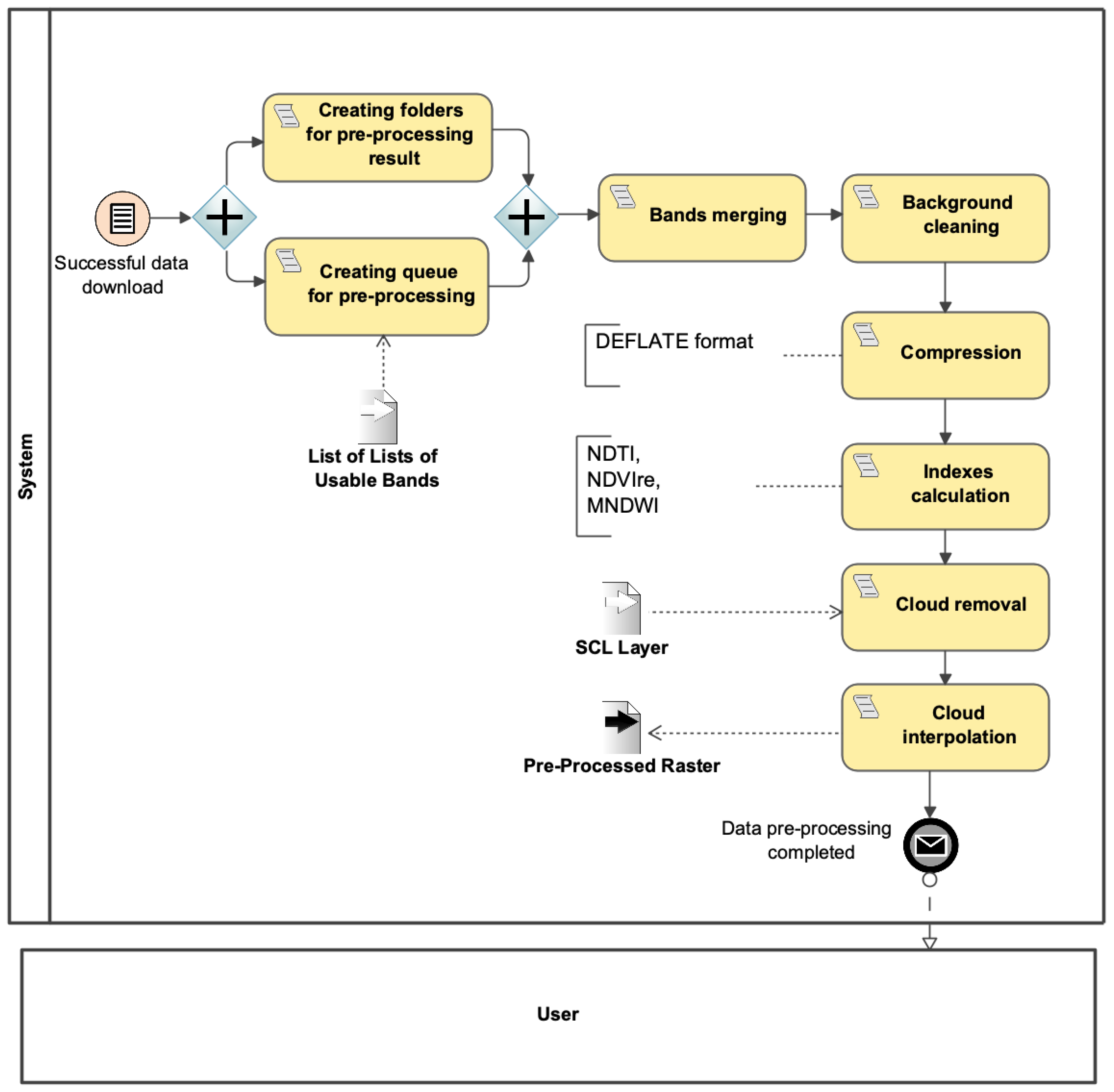


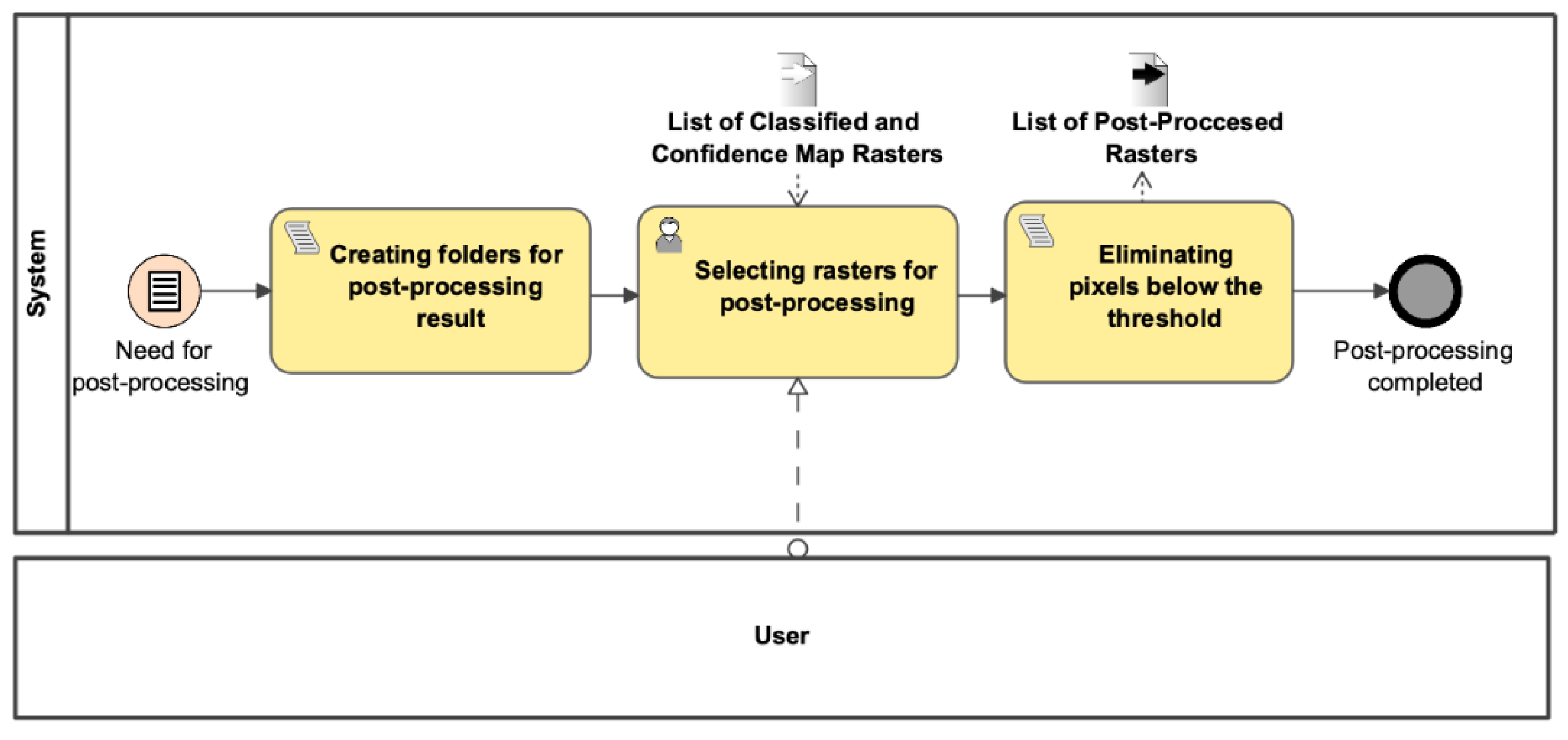

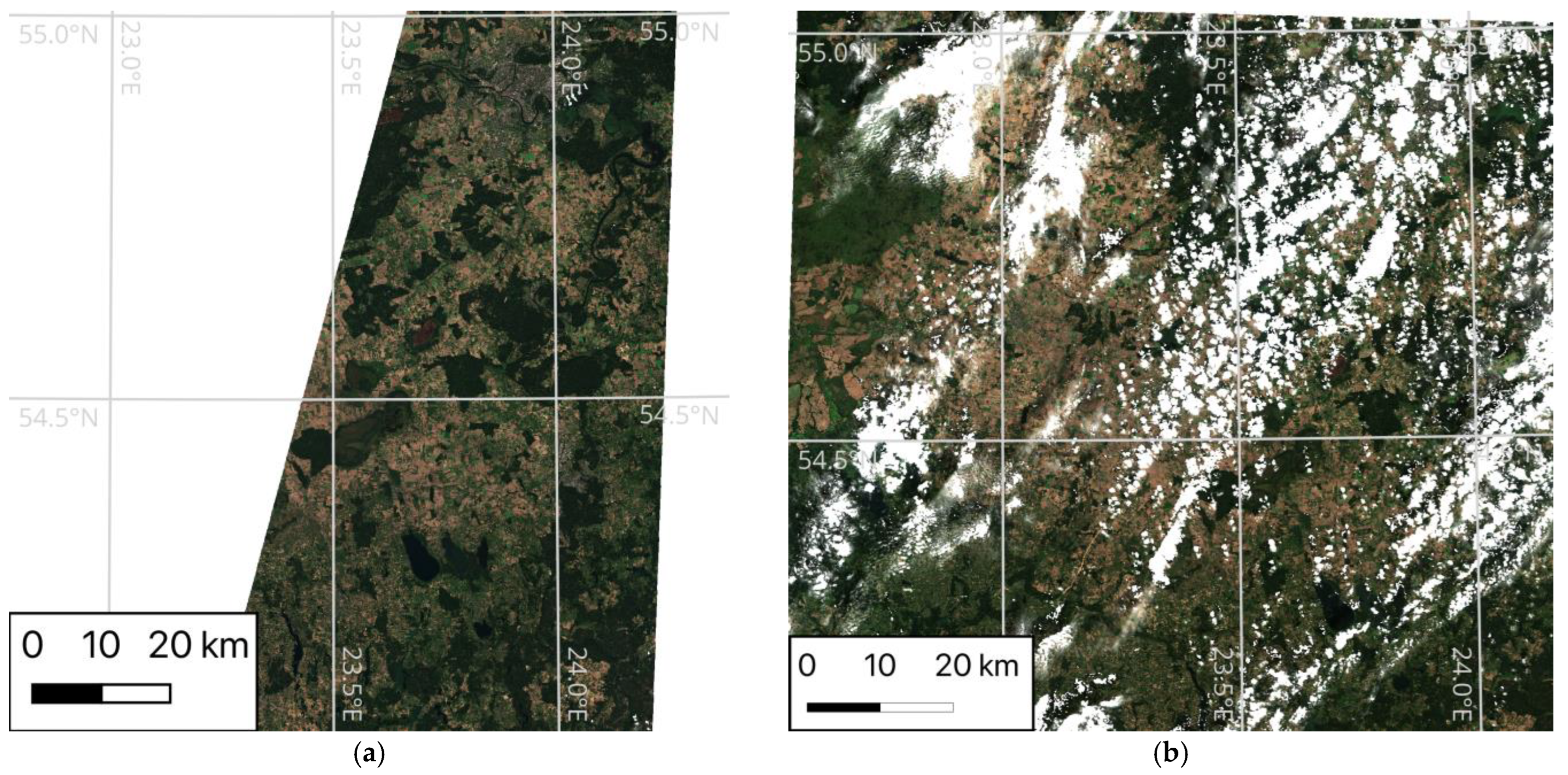

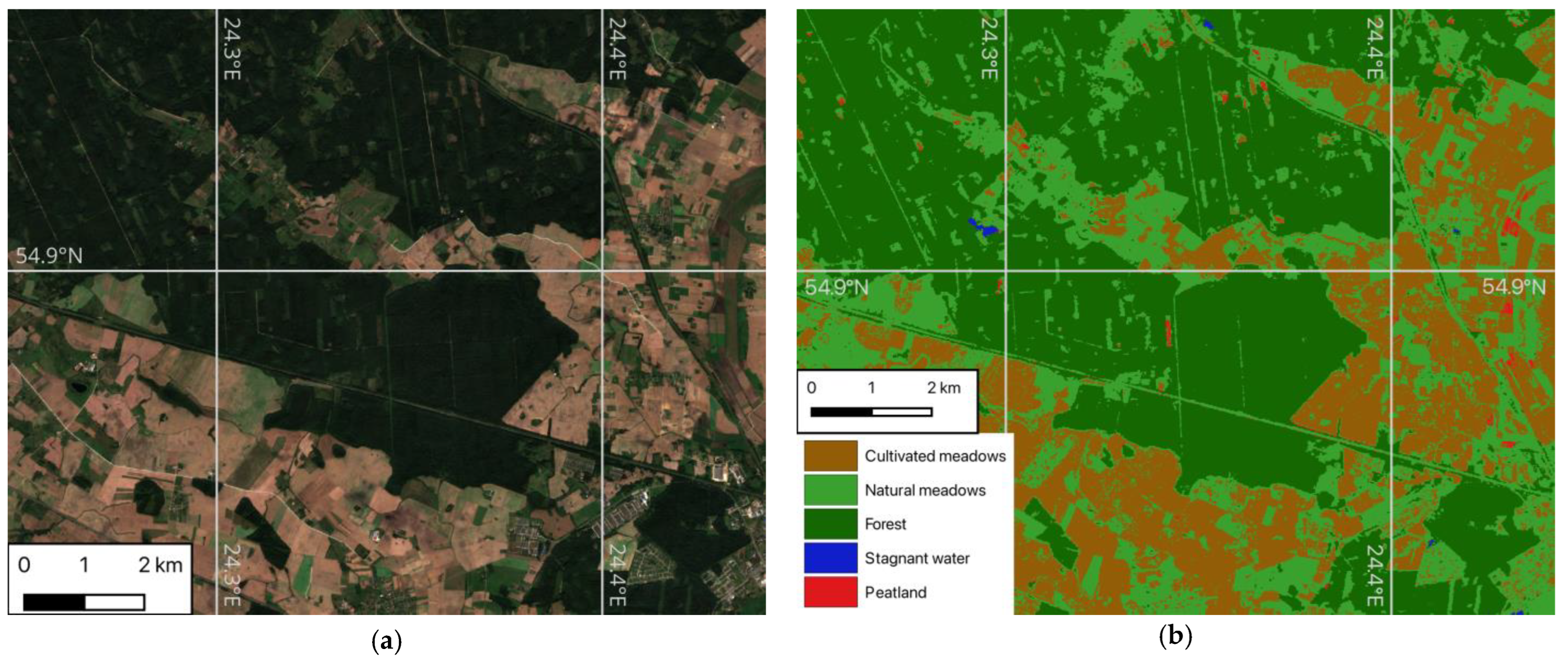
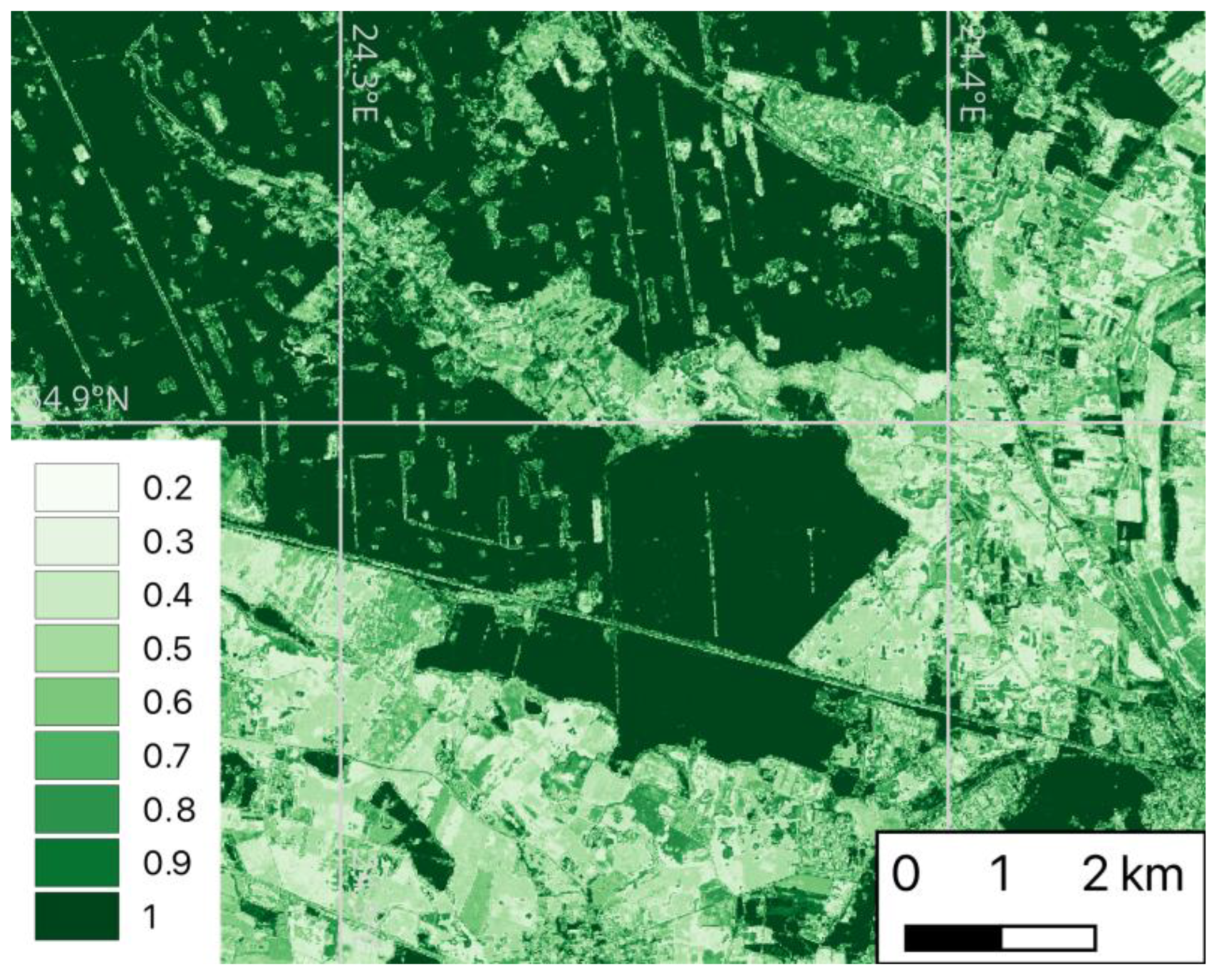
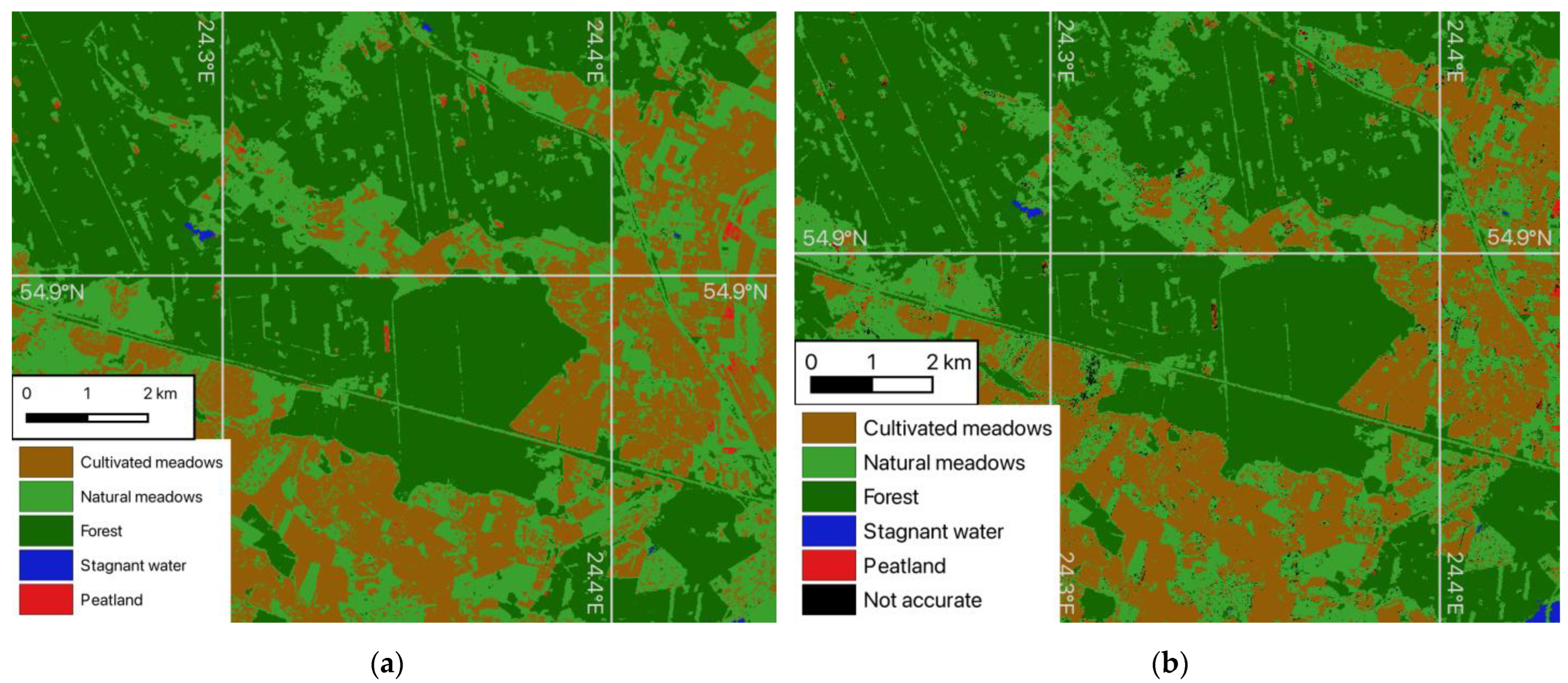
| Reference | Algorithm | Accuracy Metrics | Analyzed Region | Cloud Problem Handling |
|---|---|---|---|---|
| (1) | (2) | (3) | (4) | (5) |
| [16] | RF | OA = 74.3% | Nice, France | Used pre-processed cloud-free Sentinel-2 images |
| [4] | RF | OA = 91.78% | Northern Croatia | Used Sentinel-1 SAR and Sentinel-2 optical data, applied cloud masking strategies |
| [5] | RF, SVM | OA = 98.66%, CK = 98.23% | Inner Mongolia | Applied object-oriented methods to mitigate noise, no specific mention of cloud handling |
| [7] | RF | OA = 88.18%, P = 93.55%, R = 89.93%, F = 91.67% | Ethiopia | Multi-temporal cloud-free compositing approach |
| [9] | RF | OA = 95.64%, CK = 94% | Yancheng, China | Sentinel-2 cloud masking and shadow removal techniques |
| [8] | RF | OA = 91.2%, CK = 85%, F1 = 91.04% | Various crop fields | Multi-temporal imagery for cloud interpolation |
| [22] | CNN | F1 = 75.49% | Global | Used deep learning for cloud detection and mitigation in high-resolution images |
| [23] | RF | OA = 94.78%, F1 = 78.32% | Flood-prone areas | Combined cloud-free mosaicking with SAR data |
| [24] | RF | OA = 91.46% | Canada | Scene Classification Layer (SCL) for cloud segmentation |
| [25] | NDVIML | OA = 83.75% | Agroforestry areas | Cloud filtering via NDVI-based thresholding |
| [6] | RF, CNN | OA = 90.3% | Remote sensing datasets | Combination of cloud masking and deep learning interpolation |
| [26] | CNN | GA = 88% | Manitoba, Canada | Not specified |
| [27] | SVM, RF | OA = 86% | Krakow, Poland | Sentinel-2 imagery pre-processing; addressed cloud interference implicitly |
| [28] | RF | OA = 88.16% | Lingbei Rare Earth Mining Area, China | Not explicitly mentioned (hyperspectral data used, which is generally less affected by cloud issues than optical data) |
| [29] | OBIAFL | OA = 95.32% | Pavia, Italy | Not specified |
| [30] | VSM | Not specified | Coastal zones in California, USA | Not specified |
| [31] | GBM, RF | OA = 87% | Queensland, Australia | Explicitly addresses cloud issue; RF efficiently interpolates missing pixels caused by clouds |
| [32] | KNN, DT, SVM, RF | OA = 81% | Algarve, Portugal | Uses good quality pre-processed Sentinel-2 Level-2A products |
| [33] | SVM, RF | F1 = 91.4% | Bulgaria | Uses images with cloud cover <10% and apply cloud, shadows and defective pixel masking |
| [34] | RF, SVM, XGB | OA = 83–96% F1= 73–97% | Tatra Mountains, Central Europe | Authors use high quality Sentinel-2 Level-2A products |
| [35] | RF, SVM | F1 = 93% | Tatra Mountains, Central Europe | Selects only those Sentinel-2 Level-2A scenes that exhibit minimal cloud cover |
| [36] | KNN, SVM, DT, RF | CK = 87% | Central Iran | Cloudy images omitted (dry climate) |
| [37] | RF, KNN | R2 = 87% | Central Greece | Cloud masking |
| [38] | KNN, SVM, RF | OA = 86–93% | China | Not specified |
| [39] | RF, SVM, DT, CART | OA = 94.8%, CK = 93% | Nainital, India | Authors use Google Earth Engine (GEE) for cloud free images |
| [40] | SVM, RF | OA = 90.11%, CK = 87%, F1 = 88.46% | Catalonia | Authors handle cloud problems in their analysis by using atmospheric and geometric corrections |
| [41] | SVM, RF, KNN, LR | R2 = 79% | Jilin Province, Northeast China | Sen2Cor tool applied |
| [42] | RF, SVM | OA = 94.03%, | Lake Basin, Iran | Not specified |
| [43] | RF, CART | R2 = 94.1% | Romania | Authors use Google Earth Engine (GEE) for cloud free images |
| [44] | RF | OA = 87.15% | Central Italy | Cloud masking |
| Region | Sentinel-2 Tiles |
|---|---|
| Žemaitija | 34UDG, 34VDH, 34UEG, 34VEH |
| Aukštaitija | 34VFH, 34UFG, 35VLC, 35ULB, 35UMB, 35VMC |
| Suvalkija | 34UFF, 34UFE, 35ULA, 34UGE |
| Dzūkija | 35ULV, 35UMA, 35UMV |
| Classifier | Optimal Hyperparameters |
|---|---|
| RF | n_estimators = 100, max_depth = 20, min_samples_leaf = 4, min_samples_split = 2 |
| SVM | C = 0.1, gamma = scale, kernel = rbf |
| KNN | n_neighbors = 10, weights = uniform, p = 2 |
| Classifier | Cohen’s Kappa | F1-Score | Recall | Precision |
|---|---|---|---|---|
| RF | 89.23% | 90.53% | 90.86% | 90.21% |
| SVM | 86.23% | 87.93% | 88.16% | 87.71% |
| KNN | 84.73% | 85.08% | 85.36% | 84.81% |
| Month | OA | Precision | Recall | F1 | Cohen’s Kappa |
|---|---|---|---|---|---|
| April | 90.45% | 92.69% | 91.45% | 92.07% | 90.96% |
| May | 91.67% | 92.28% | 90.59% | 91.43% | 90.05% |
| June | 90.40% | 93.55% | 90.40% | 91.95% | 88.50% |
| July | 93.97% | 97.20% | 92.97% | 95.04% | 93.62% |
| August | 90.61% | 91.10% | 90.61% | 90.85% | 90.03% |
| September | 90.06% | 96.26% | 90.06% | 93.06% | 89.69% |
| October | 93.13% | 93.43% | 93.13% | 93.28% | 90.13% |
| Land Use Class | CC | Month | ||||||
|---|---|---|---|---|---|---|---|---|
| April | May | June | July | August | September | October | ||
| CV | CV | CV | CV | CV | CV | CV | ||
| Arable land | 11 | 0.3 | 0.32 | - | - | 0.26 | 0.38 | 0.32 |
| Fallow | 12 | - | - | 0.41 | 0.43 | - | - | - |
| Stubble | 13 | - | - | - | - | 0.47 | - | - |
| Winter cereals | 14 | - | 0.3 | - | - | - | - | - |
| Intermediate crops | 15 | - | - | - | - | - | - | 0.46 |
| Intensive cultivated crops | 16 | - | 0.37 | 0.49 | 0.4 | 0.55 | - | - |
| Natural meadows | 21 | 0.36 | 0.36 | 0.29 | 0.29 | 0.45 | 0.46 | 0.55 |
| Forest | 31 | 0.3 | 0.3 | 0.39 | 0.39 | 0.31 | 0.46 | 0.4 |
| Stagnant Water | 41 | 0.25 | 0.25 | 0.25 | 0.34 | 0.25 | 0.25 | 0.25 |
| Urban areas | 51 | 0.43 | 0.43 | 0.58 | 0.68 | 0.39 | 0.63 | 0.68 |
| Sand dunes | 61 | 0.54 | 0.54 | 0.48 | 0.48 | 0.25 | 0.3 | 0.5 |
| Peatlands | 62 | - | 0.5 | 0.39 | 0.39 | 0.39 | 0.53 | 0.3 |
Disclaimer/Publisher’s Note: The statements, opinions and data contained in all publications are solely those of the individual author(s) and contributor(s) and not of MDPI and/or the editor(s). MDPI and/or the editor(s) disclaim responsibility for any injury to people or property resulting from any ideas, methods, instructions or products referred to in the content. |
© 2025 by the authors. Licensee MDPI, Basel, Switzerland. This article is an open access article distributed under the terms and conditions of the Creative Commons Attribution (CC BY) license (https://creativecommons.org/licenses/by/4.0/).
Share and Cite
Jancevičius, J.; Kalibatienė, D. Application of Image Recognition Methods to Determine Land Use Classes. Appl. Sci. 2025, 15, 4765. https://doi.org/10.3390/app15094765
Jancevičius J, Kalibatienė D. Application of Image Recognition Methods to Determine Land Use Classes. Applied Sciences. 2025; 15(9):4765. https://doi.org/10.3390/app15094765
Chicago/Turabian StyleJancevičius, Julius, and Diana Kalibatienė. 2025. "Application of Image Recognition Methods to Determine Land Use Classes" Applied Sciences 15, no. 9: 4765. https://doi.org/10.3390/app15094765
APA StyleJancevičius, J., & Kalibatienė, D. (2025). Application of Image Recognition Methods to Determine Land Use Classes. Applied Sciences, 15(9), 4765. https://doi.org/10.3390/app15094765







